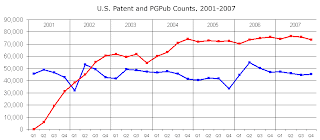
2007 was a bit of a mixed bag for U.S. patents and published applications. In Q4 the USPTO published 73,450 applications, the lowest number in more than a year and a 3 percent drop from the same quarter in 2006. However, the total number of PGPubs for the calendar year was 300,198, a 1.87 percent increase over 2006. This is the first year that PGPubs have exceeded the 300,000 mark. Approximately 1.6 million applications have been published since 2001. The USPTO issued 45,401 patents in Q4, a 3 percent decline from the same period in 2006. The total number of patents issued in 2007 dropped to 183,128, which is 13,485 or 6.86 percent fewer than 2006. Weekly issues and PGpubs were relatively stable with few peaks or canyons. (See Table 2.) According the the USPTO's FY2007 annual report released in November, inventors set another record for new filings, submitting 467,243 applications, a 4.85 percent increase over 2006. In order to deal with this continuing growth the USPTO hired another 1,215 examiners in FY2007, bringing the total patent examining corps to 5,477. Despite the additional staff the backlog of pending patent applications grew to 1,112,517, a 10.82 percent increase over FY2006.
Table 1. Quarterly Patent and PGPub Counts*
Quarter ..... Patents ..... PGPubs ..... Totals
Q1 ..... 47,332 ..... 74,277 ..... 121,609
Q2 ..... 45,828 ..... 76,640 ..... 122,468
Q3 ..... 44,567 ..... 75,831 ..... 120,398
Q4 ..... 45,401 ..... 73,450 ..... 118,851
2007 ..... 183,128 ..... 300,198 ..... 483,326
*Based on weekly data from the USPTO's PatFT and AppFT databases. Weekly totals may change after the fact due to withdrawn patents and published applications.
Table 2. Weekly Averages and Medians for 2007
Patents ..... 3,515 ..... 3,539
PGPubs ..... 5,762 ..... 5,659
Table 3. Number Ranges for 2007
Patents ..... 7,155,746 - 7,313,828
Reissues ..... RE39,452 - RE39,963
PGPubs ..... 2007/0000001 - 2007/0300346
Designs ..... D534,332 - D558,425
Plants ..... PP17,326 - PP18,372
SIRs ..... H2,177 - H2,207
Table 4. Withdrawn Patent and PGPub Numbers in 2007
Patents ..... 831
PGPubs ..... 143
Predictions for 2008
Last year I predicted that the USPTO would adopt series code 12 for utility and plant patent applications before the end of 2007. We won't know for sure for a few months, but the USPTO is on track to run out of serial numbers for series 11 before the end of the year. Recently published applications filed in September have serial numbers in the 850,000-855,000 range. Applications are published 18 months from the earliest priority filing date (provisional or foreign), which means that many new applications are published 6 months (or less) after filing. So it looks like series 12 will be appearing on or about Jan. 1. Series code 11 was adopted on Dec. 1, 2004.
